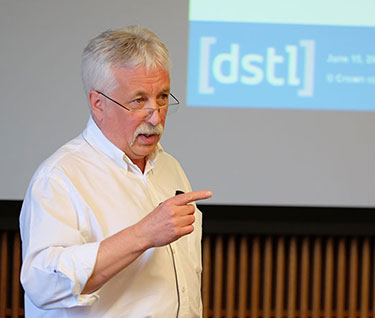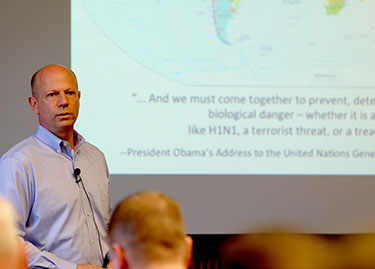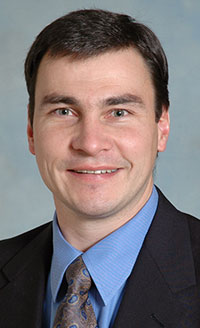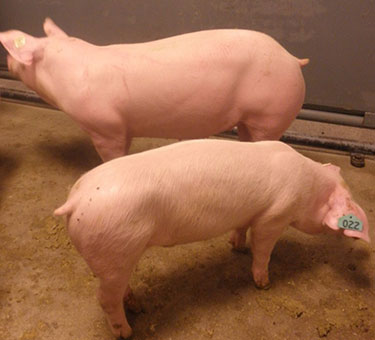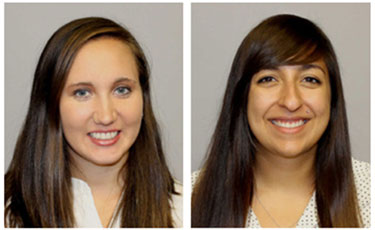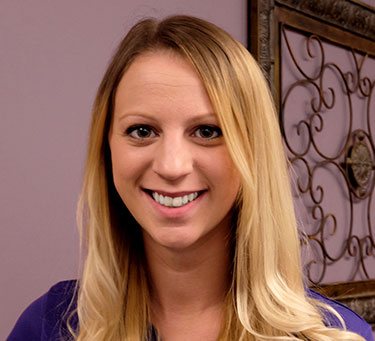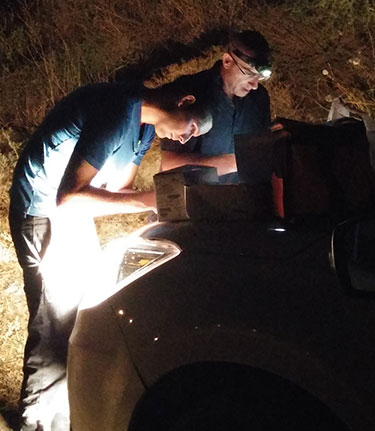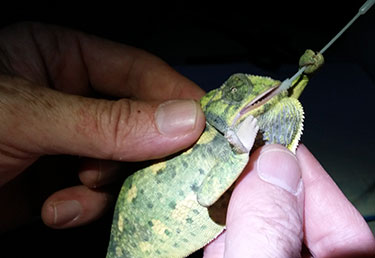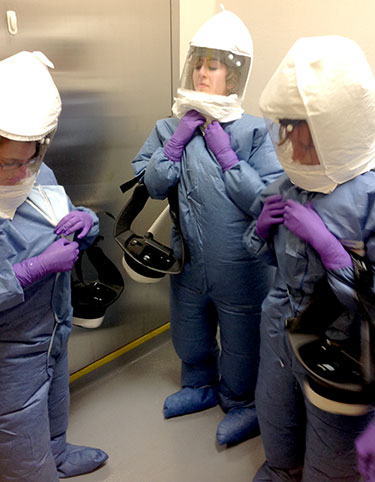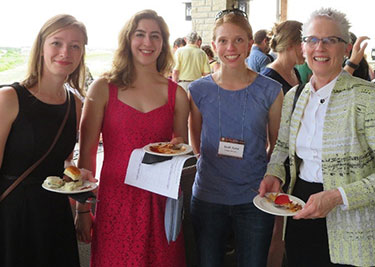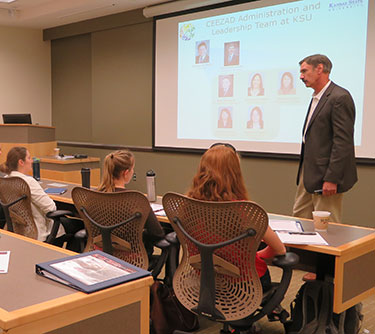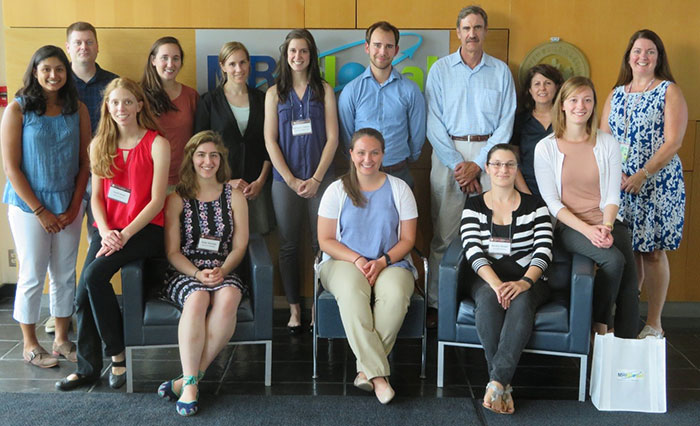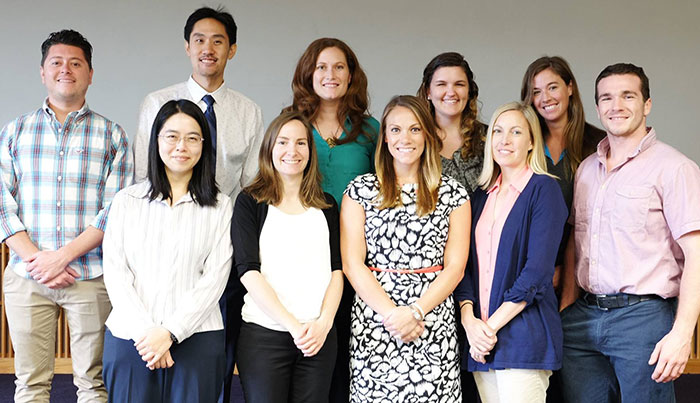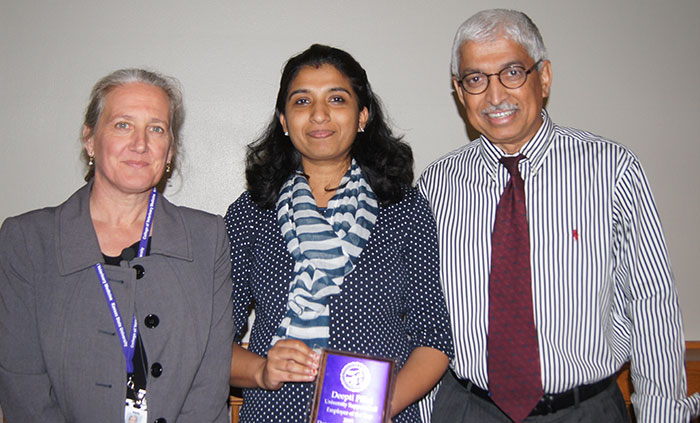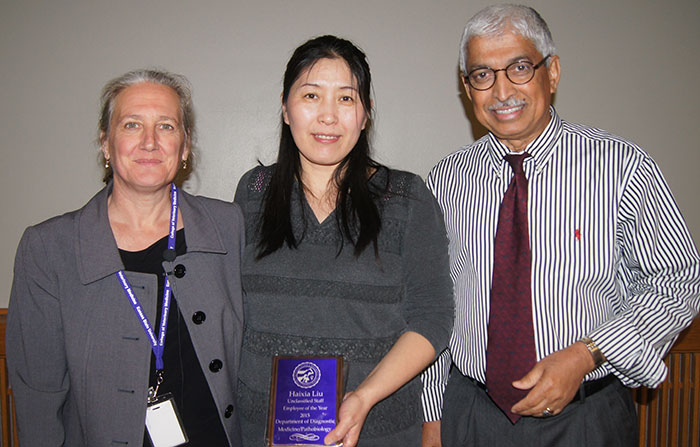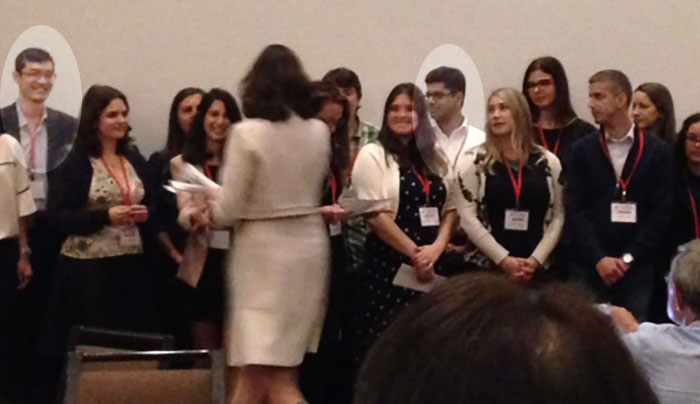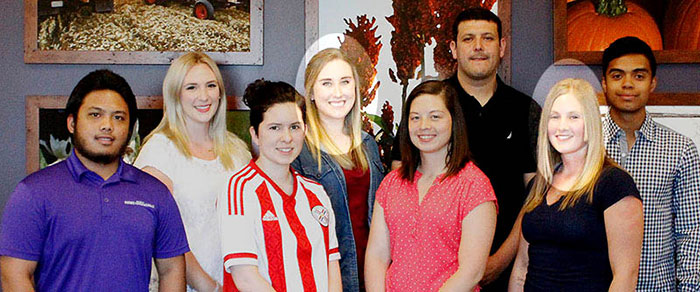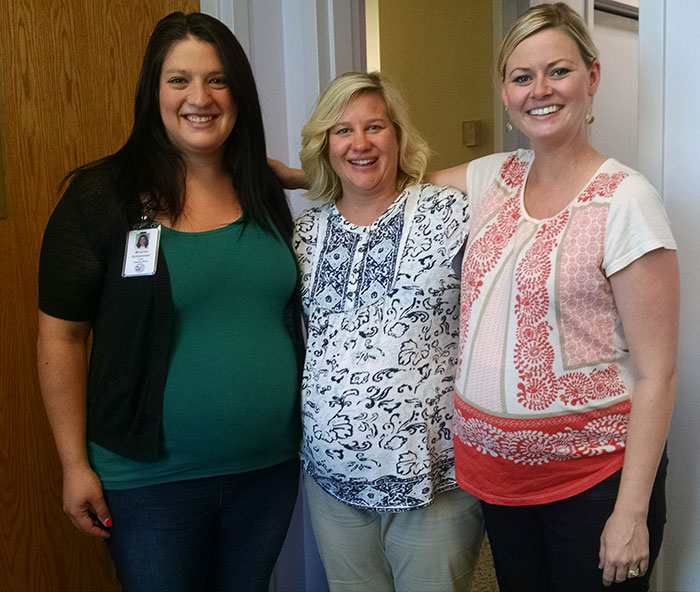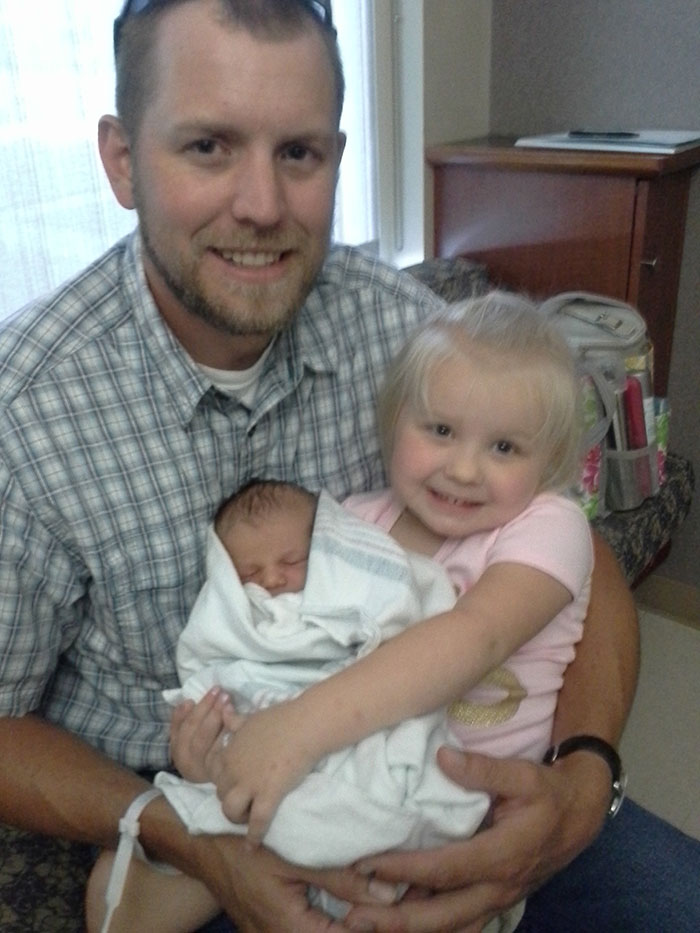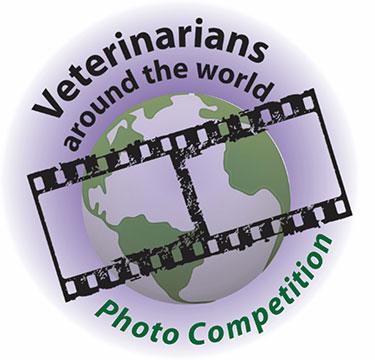
July 2016 - Vol. 11, No. 7
Top Stories
Twinning in Tanzania
OIE supports twinning program between CVM and Sokoine University
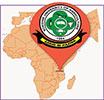
The College of Veterinary Medicine at Kansas State University is pleased to announce the establishment of a twinning partnership with Sokoine University of Agriculture Faculty of Veterinary Medicine in Morogoro, Tanzania, which has been formed through a program administered by the World Organisation for Animal Health (OIE) in Paris, France.
The Veterinary Education Establishment Twinning Program was established by the OIE in 2013 and has since supported partnerships between well-matched, eligible veterinary education establishments. The program aims to strengthen veterinary education by establishing partnerships which lead to exchanges of ideas, knowledge and experiences for students and faculty.
Challenging Conventions
ICCM study reevaluates food safety assessment method
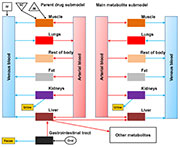
Research by Kansas State University's Institute of Computational Comparative Medicine is challenging conventional thought regarding human food safety and drug residues found in cattle and swine tissues.
In the study "Human Food Safety Implications of Variation in Food Animal Drug Metabolism" published recently in Nature's Scientific Reports, Kansas State University researchers Drs. Zhoumeng Lin, Christopher Vahl and Jim Riviere found that diseases can dramatically influence the type of drug residue found in tissues of food animals that are tested by regulatory agencies in monitoring human food safety.
CVM hires Dr. Peggy Schmidt as new Associate Dean for Academic Programs and Student Affairs
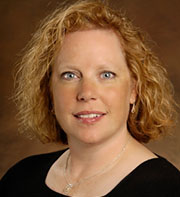
The College of Veterinary Medicine at Kansas State University has announced the hiring of Dr. Peggy Schmidt as its new associate dean for academic programs and student affairs, joining the college Sept. 6. Dr. Schmidt has been a faculty member in veterinary education for 12 years, and served as an academic director for nine of those years. She currently serves Western University of Health Sciences as director of outcomes assessment. Prior to this role, Dr. Schmidt was the director of the year 4 curriculum. She is also an associate professor of population health and epidemiology.
UK and US security experts call for cooperation between veterinarians and international agencies
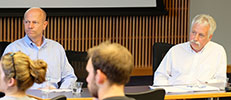 A pair of UK and US security experts called for greater cooperation between veterinarians and international agencies toward reducing biological threats and improving international security during a recent visit to the College of Veterinary Medicine at Kansas State University.
A pair of UK and US security experts called for greater cooperation between veterinarians and international agencies toward reducing biological threats and improving international security during a recent visit to the College of Veterinary Medicine at Kansas State University.
The experts, Andrew Weber, former assistant secretary of defense and deputy coordinator for Ebola response at the U.S. Department of State; and David Elliott, a leader in cooperative threat reduction at Defense Science and Technology Laboratories, UK government, spoke about the relationship between global security and outbreaks of animal and zoonotic diseases.
More Headlines
CVM names Dr. Hans Coetzee as new head of Department of Anatomy and Physiology

The College of Veterinary Medicine at Kansas State University has named Dr. Hans Coetzee (pronounced could-see) as its new department head for the Department of Anatomy and Physiology. Dr. Coetzee returns to the College of Veterinary Medicine where he was on the faculty from October 2005 to July 2011, before accepting a position with Iowa State University’s College of Veterinary Medicine, where he was a professor and section leader for its Pharmacology Analytical Support Team. He will join Kansas State University Oct. 1.
Dr. Megan Niederwerder examines microbiome associations related to PRRS and PCV2
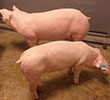 Researchers in the College of Veterinary Medicine at Kansas State University have teamed up with the Lawrence Livermore National Laboratory in California to evaluate the impact and association of microbiomes in connection with two of the most devastating viral diseases in swine.
Researchers in the College of Veterinary Medicine at Kansas State University have teamed up with the Lawrence Livermore National Laboratory in California to evaluate the impact and association of microbiomes in connection with two of the most devastating viral diseases in swine.
“Understanding how the microbiome impacts health and disease in swine is a relatively new field of study,” said Dr. Megan Niederwerder, the lead author and an assistant professor in the Department of Diagnostic Medicine/Pathobiology and Kansas State Veterinary Diagnostic Laboratory.
Veterinary students land international travel awards for research projects
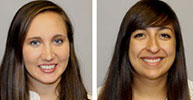 Two veterinary students will work on research projects overseas as recipients of 2016 international student travel awards from the office of International Programs. This year’s recipients are both third-year veterinary medicine students. Sohaila Jafarian, Manhattan, will work on a One Health water sanitation project in Managua, Nicaragua. Marie Keith, Maple Hill, will work on a rabies project at the Division of Infectious Diseases at the Chinese Center for Disease Control and Prevention in Beijing.
Two veterinary students will work on research projects overseas as recipients of 2016 international student travel awards from the office of International Programs. This year’s recipients are both third-year veterinary medicine students. Sohaila Jafarian, Manhattan, will work on a One Health water sanitation project in Managua, Nicaragua. Marie Keith, Maple Hill, will work on a rabies project at the Division of Infectious Diseases at the Chinese Center for Disease Control and Prevention in Beijing.
Guinea pigs help veterinary student win third-place prize in Smithcors History Essay contest
 An “endearing” essay about the history of some favorite fuzzy pets recently earned a third-place prize for Kelsey Madden, Olathe, Kansas, in the 2016 J. Fred Smithcors Student Veterinary History Essay Contest.
An “endearing” essay about the history of some favorite fuzzy pets recently earned a third-place prize for Kelsey Madden, Olathe, Kansas, in the 2016 J. Fred Smithcors Student Veterinary History Essay Contest.
Madden, who just finished her first year of studies in the College of Veterinary Medicine at Kansas State University, also earned an $800 award for the essay, which she had revised from a paper for history of veterinary medicine class, called “The Guinea Pig: Endearing, Enduring or Both?”
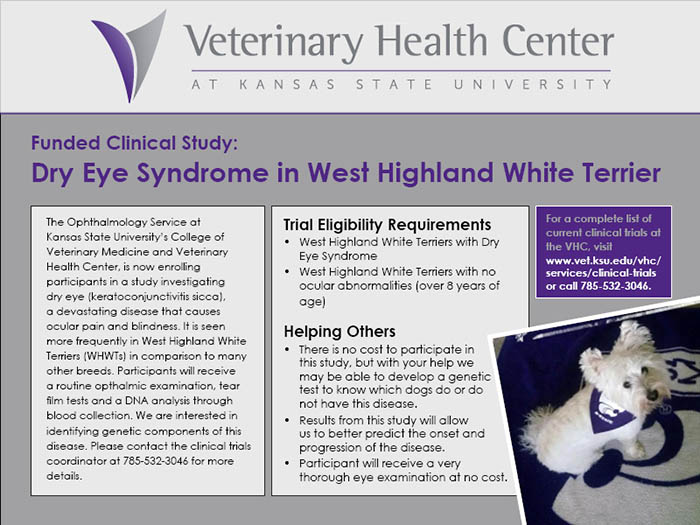
Video Feature
CVM's Strategic Planning initiative
The College of Veterinary Medicine announced a new strategic planning initiative in May. In the video, Dean Tammy Beckham explains why participation is important from all the college's stakeholders. What does the future of veterinary education, animal health, teaching, research and service look like? Where do we need to be? Your participation and thoughtful opinions can help make our college the elite institution that it should be.
The CVM also held a picnic to promote awareness and participation in the Strategic Planning efforts on June 29. Faculty, staff and students attended and received a special goody bag with "Creating Our Future Together" items. (Video produced by Kent Nelson; Pictures by Audrey Hambright.)
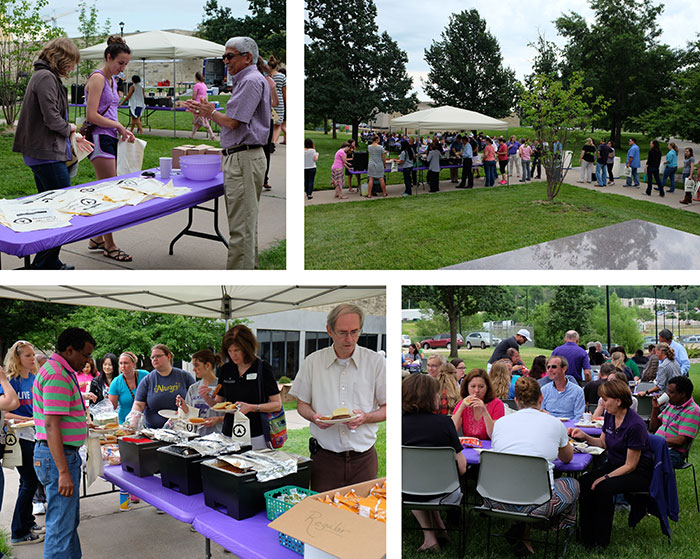
Dr. David Eshar conducts summer field pathogen surveillance on wild chameleons in Israel
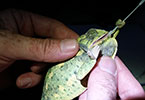 It is just before midnight, and a full moon is shining its strong beam, helping Kansas State University’s Dr. David Eshar and his colleagues find and sample wild common chameleons (or Mediterranean chameleons) in Israel. “The chameleons are diurnal animals that spend the nights sleeping mainly on Jujube and Carob trees, that are now in full blossom and attracting their prey of various insects,” explained Dr. Eshar, assistant professor of wildlife and zoo medicine in the College of Veterinary Medicine.
It is just before midnight, and a full moon is shining its strong beam, helping Kansas State University’s Dr. David Eshar and his colleagues find and sample wild common chameleons (or Mediterranean chameleons) in Israel. “The chameleons are diurnal animals that spend the nights sleeping mainly on Jujube and Carob trees, that are now in full blossom and attracting their prey of various insects,” explained Dr. Eshar, assistant professor of wildlife and zoo medicine in the College of Veterinary Medicine.
CEEZAD Transboundary Animal Disease Summer Program Provides a Unique Opportunity for Future Veterinary Professionals
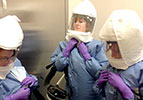
Ten future veterinary professionals with an interest in transboundary disease research took part in a two-week training program conducted by the Center of Excellence for Emerging Zoonotic and Animal Diseases (CEEZAD) at Kansas State University in coordination with the Biosecurity Research Institute (BRI). The program involved one week of exposure to operations, safety techniques and laboratory principles of high-containment biosafety level 3 (BSL-3) work at the BRI followed by a second week of visits to institutions involved in the animal health industry and lectures.
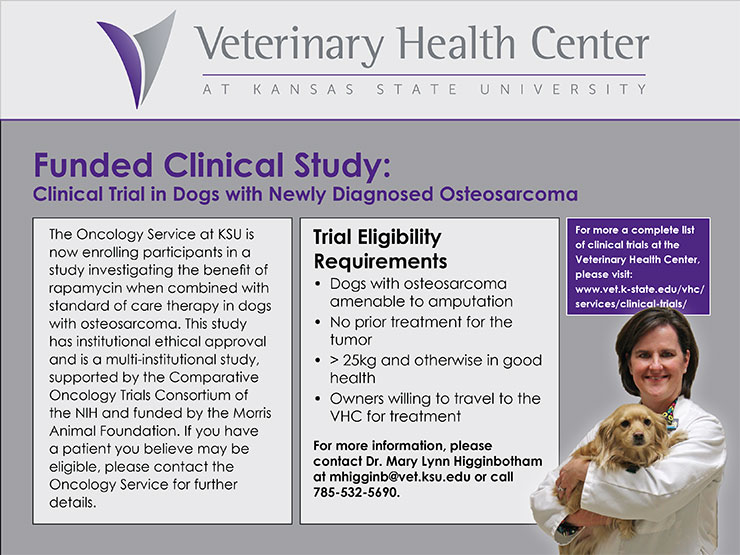
International Programs sponsors 'Veterinarians around the world' photo competition
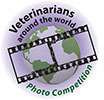 The CVM's office of International Programs announces the launch of the "Veterinarians around the world" photo competition. The theme for the competition is international veterinary medicine. Entries should capture efforts to improve animal health, public health or wildlife/ecosystem health; food security (sustainable production systems); food safety; capacity building; animal welfare; or biological threat reduction. Any other subjects relating to international veterinary medicine will also be considered.
The CVM's office of International Programs announces the launch of the "Veterinarians around the world" photo competition. The theme for the competition is international veterinary medicine. Entries should capture efforts to improve animal health, public health or wildlife/ecosystem health; food security (sustainable production systems); food safety; capacity building; animal welfare; or biological threat reduction. Any other subjects relating to international veterinary medicine will also be considered.
Undergrad students receive Histochemical Society Capstone Grants for research projects under Dr. A. Sally Davis
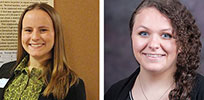 A pair of undergraduate students at Kansas State University, Kaitlynn Bradshaw and MaRyka Smith, have successfully applied for research grants to support their projects under the mentorship of Dr. A. Sally Davis, an assistant professor of experimental pathology in the College of Veterinary Medicine. The $500 awards are provided through the Histochemical Society’s new Capstone Grant program, which has the objective of promoting the use of immunohistochemistry or other histochemical techniques in biological research. Bradshaw and Smith are two of the first three students to receive one of these grants.
A pair of undergraduate students at Kansas State University, Kaitlynn Bradshaw and MaRyka Smith, have successfully applied for research grants to support their projects under the mentorship of Dr. A. Sally Davis, an assistant professor of experimental pathology in the College of Veterinary Medicine. The $500 awards are provided through the Histochemical Society’s new Capstone Grant program, which has the objective of promoting the use of immunohistochemistry or other histochemical techniques in biological research. Bradshaw and Smith are two of the first three students to receive one of these grants.
Regular features
Alumni Events, Development and Continuing Education
 The Veterinary Medical Alumni Association presents its annual alumni recognition awards at the 78th Annual Conference for Veterinarians and the Kansas Veterinary Medical Association presents its annual awards the next day at the conference. Find out who this year's winners are below.
The Veterinary Medical Alumni Association presents its annual alumni recognition awards at the 78th Annual Conference for Veterinarians and the Kansas Veterinary Medical Association presents its annual awards the next day at the conference. Find out who this year's winners are below.
Pet Friendly License Plate program in Kansas
The College of Veterinary Medicine has a new way to support shelter medicine in Kansas. The Pet Friendly license plate is available to Kansas residents statewide by visiting your local Kansas county treasurer's office.
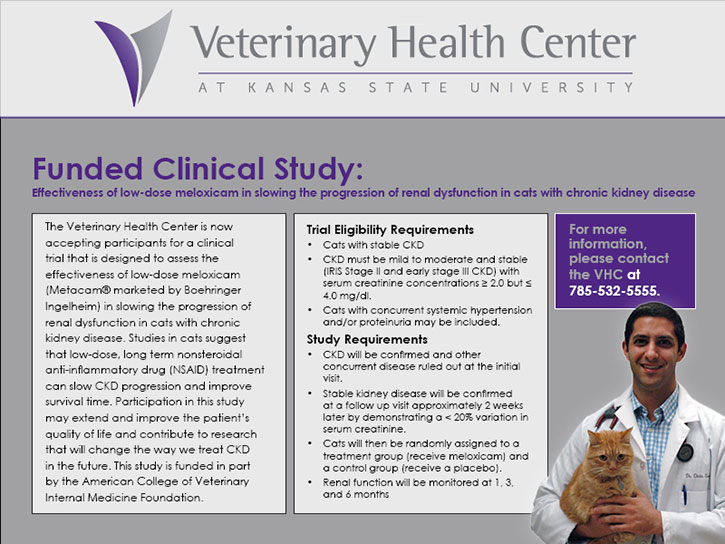
News Ticker
More activities and accomplishments in the College of Veterinary Medicine:
|
Drs. Laura Armbrust, Paxton Harness, Mary Lynn Higginbotham, Susan Nelson, Raelene Wouda, Marjory Artzer, Lisa Pohlman, Adi Naor, David Biller: “Evaluation of subcutaneous masses utilizing shear wave elastography in dogs.” Mark Derrick Canine Research funds - $7,620. Dr, Thomas Schermerhorn: “Relationships between serum tonicity and hyperglycemia in diabetic dogs.” Mark Derrick Canine Research funds - $8,950. He also presented at the American College of Veterinary Internal Medicine forum in Denver. “Hypertonicity and its complications in diabetes” and “Diagnosis of adrenal disease in dogs.” Dr. Mike Apley presented at the Vermont Veterinary Medical Association in Burlington, Vermont. Topics: Antibiotic resistance and antibiotic use in animals and humans; The veterinary feed directive and other upcoming changes in regulations for drug use in food animals; A joint one-health session on antimicrobial resistance; and Evaluating clinical signs and lung lesions in calves with bovine respiratory disease. He also presented at the Cowboy College in Des Moines, Iowa. Topic: Vaccination programs, antibiotic decisions, and herd health. The Shelter Medicine Mobile Surgery Unit continues to receive media press. The Ottawa Herald published, “Mobile Surgery Unit aids Prairie Paws and other shelters.” The mobile unit spent 218 days on the road in its first year regularly visiting 12 area shelters and performing 3,499 spay/neuter surgeries. Anna “Clarisse” Leppien, in Central Preparation, passed the exam June 21 and is now a Certified Registered Central Service Technician (CRCST). Dr. David Eshar was elected by his peers to become the Chair of the Small Mammal sub-specialty of the European College of Zoological Medicine (ECZM) and a member of the Executive Committee of the college. Dr. James Carpenter was named as one of the 15 Most Influential Veterinarians in 2016 by veterinarianedu.org. Dr. A. Sally Davis was awarded the following grant/fellowships in June 2016: Kansas State University Office for the Advancement of Women in Science and Engineering’s ADVANCE Distinguished Lecture Series grant, $1,200; University of Kansas NIH COBRE Protein Structure and Function pilot project “Characterization of protease TMPRSS2 and its interaction with influenza A,” $41,000 direct costs; and the Big 12 fellowship with mentoring component application to be mentored by Gillian Air, University of Oklahoma Health Sciences Center entitled “Elucidating Rift Valley fever virus’ binding and entry mechanisms guided by its tissue tropism and glycan engagement,” $2,500. She also an editorial board member for the Nature publication Scientific Reports and had three new publications this past month three as a co-author and one as a co-first author: Wilson WC, Davis AS*, Gaudreault NN, Faburay B, Trujillo JD, Shivanna V, Sunwoo SY, Balogh A, Endalew A, Ma W, Drolet B, Ruder MG, Morozov I, McVey DS, Richt JA. 2016. (*=co-first). Experimental Infection of Calves by Two Genetically Distinct Strains of Rift Valley Fever Virus. Viruses. 2016; 8(5).; Faburay B, Wilson WC, Gaudreault NN, Davis AS, Shivanna V, Bawa B, Sunwoo SY, Ma W, Drolet B, Morozov M, McVey DS, Richt JA. 2016. A Recombinant Rift Valley Fever Virus Glycoprotein Subunit Vaccine Confers Full Protection against Rift Valley Fever Challenge in Sheep. Scientific Reports. 2016; 6:27719.; and Kutty G, Davis AS, Ferreyra GA, Qiu J, Huang DW, Sassi M, Bishop L, Handley G, Sherman B, Lempicki R, Kovacs JA. b-glucans are Masked but Contribute to Pulmonary Inflammation During Pneumocystsis Pneumonia. J Infect Dis. 2016 (In Press). |
||
VHC welcomes new class of interns
Back row: Drs. Erik Perez, equine; Pierce Chan, small animal medicine & surgery; Megan Partyka, small animal medicine & surgery; Kyla Krissek, shelter medicine; and Katie Weatherall, equine. Front row: Drs. Lin-Yi Hsuan, small animal medicine & surgery; Lauren Pudenz, small animal medicine & surgery; Christina McCullough, livestock services; Lacey Robinson, livestock services; and Louden Wright, zoological medicine. |
||
CVM recognizes Employees of the Year and Years of Service at Kansas State University
Deepti Pillai receives the University Support Staff Employee of the Year Award for the Department of Diagnostic Medicine/Pathobiology, presented by Dean Tammy Beckham and Department Head Dr. M.M. Chengappa.
Haixia Liu accepts the Unclassified Staff Employee of the Year Award from Dean Beckham and Dr. Chengappa. The following employees were recognized for years of service.
CEEZAD holds open house at its new location in the KSU Office Park
Officials of the Center of Excellence for Emerging and Zoonotic Animal Diseases (CEEZAD) celebrated the opening of its new headquarters June 22 with an open house attended by stakeholders, collaborators, and Kansas State University officials. Dr. Juergen Richt, Regents Distinguished Professor, Diagnostic Medicine and Pathology at Kansas State University and director of CEEZAD, welcomed the dignitaries at an evening reception held at the offices, which are in the KSU Office Park. The building, which is also home to the KSU Foundation, opened in the fall of 2015. CEEZAD is a Department of Homeland Security Center of Excellence established in 2010 with a focus on the protection of the nation’s agricultural and public health sectors against high-consequence foreign animal, emerging and zoonotic disease threats. Although it has a broad mission, CEEZAD scientists concentrate their efforts in four principal areas:
Dr. Richt welcomed participants with a clear message that CEEZAD’s mission would be enhanced in its new headquarters. “As you take it in today, I’m sure you will agree with me that it is a fine, modern facility, fully appropriate for carrying forward the center’s mission of making America, and the world, safer,” he said. He noted that CEEZAD has since its inception researched efforts to enhance biodefense capabilities via threat awareness, vulnerability assessments, surveillance and detection, as well as response and recovery. “We conduct research, develop technology and train a specialized workforce to help defend U.S. agricultural systems against agroterrorism and other catastrophic events caused by high-threat transboundary, emerging and zoonotic pathogens,” he said. Among accomplishments cited by Dr. Richt to date:
In Dr. Richt’s closing remarks, he states “As we open and occupy these new offices, you can be assured that our efforts in all of these regards will continue and intensify.” These efforts are wholly or in-part supported by the U. S. Department of Homeland Security under the Center of Excellence of Emerging and Zoonotic Animal Diseases Grant Award Number 2010-ST061-AG0001. |
||
May and June updates for ICCM and NICKS
Grants: KSU Office of Research and Sponsored Programs (ORSP) University Small Research Grant (USRG). “Developing a computer model to improve pain treatment in dogs using existing data,” July 1, 2016 - June 30, 2017. $4,343. PI: Zhoumeng Lin.
Publications:
Lee C, Comer J, Herndon C, Leung N, Pavlova A, Swift R, Tung C, Rowley CN, Amaro R, Chipot C, Wang Y, Gumbart JC. Simulation-based approaches for determining membrane permeability of small compounds. J. Chem. Inf. Model. 56 (4): 721–733, 2016. Comer J, Aksimentiev A. DNA sequence-dependent ionic currents in ultra-small solid-state nanopores. Nanoscale 8 (18): 9600–9613, 2016. Aryal S, Stigliano C, Key J, Ramirez M, Anderson J, Karmonik C, Fung S, Decuzzi P. Paramagnetic Gd3+ labeled red blood cells for magnetic resonance angiography. Biomaterials 98, 163-170, 2016. Delong RK, Hurst MN, Aryal S, Inchun NK. Unique Boron Carbide Nanoparticle Nanobio Interface: Effects on Protein-RNA Interactions and 3-D Spheroid Metastatic Phenotype. Anticancer Research 36(5): 2097-103, 2016. Geoffrey N. Manani, Ryan T. Spidle, Anagh Bhaumik, Kartik Ghosh, Raja Ram Pandey, Charles C. Chusuei, Robert Delong and Adam K Wanekaya. Novel aqueous fabrication and characterization of gold coated cobalt nanoparticles. Current Bionanotechnology 1(2): 95 – 101, 2016. Lin Z, Vahl CI, Riviere JE. Human food safety implications of variation in food animal drug metabolism. Scientific Reports, 2016;6:27907.
Abstracts/ Poster Presentations:
Pitchaimania A, Nguyen TDT, Wang H, Bossmann SH, Aryal S. Gadolinium Infused Theranostic Liposomes for Anticancer Therapy. American Association of Pharmaceutical Scientists (AAPS) National Biotechnology Conference, Boston, Poster # M1017, 2016. Thomas SE, Marroquin S , DeLong RK. Elucidating the dynamics of nanoparticle-protein interaction at a biomolecular level: structural and functional studies using firefly luciferase, B328 969.43 Cell Signaling: Proteins, Pathways and Mechanisms Session. American Physiology Society, EB. San Diego, April 4, 2016. Ramani M, DeLong RK. Absorption mechanisms of poly I:C RNA onto zinc oxide Nanoparticles: Maximizing Payload”, C136, 823.4, Nanotechnology session, American Society for Biochemistry and Molecular Biology, EB. San Diego, April 4, 2016. Ramani M, Dean JM, Hurst MN, Chandran P, Monteiro-Riviere NA, DeLong RK. Cobalt oxide nanoparticle mediated delivery of splice switching oligonucleotides (SSO) RNA. The 8th World Medical Nanotechnology Congress and Exposition. Dallas, June 9, 2016.
Invited Speakers:
Comer J. "Implementing unusual force fields in NAMD". NAMD Developer Workshop, Chicago. May 27, 2016. Comer J. "Simulations at the interface between biology and synthetic materials". Université de Lorraine, Nancy, France, June 15, 2016. Dr. De Long was an invited speaker: “Characterizing the nanobio interface of bio-metal or bio-metal oxide nanoparticles: Impact on the function and delivery of proteins and RNA” and Co-Chair of Session at The 8th World Medical Nanotechnology Congress and Exposition. Dallas, June 9, 2016. Several NICKS faculty and postdoctoral fellows presented their research findings at the 8th International Nanotoxicology Congress in Boston in June.
Dr. Yang Li (spotlight left) and Dr. Abhilash Sasidharan receive travel awards
at the 8th International Nanotoxicology Congress in Boston (see list below). Dr. Ran Chen, Postdoctoral fellow of Dr. Jim Riviere received the Outstanding Poster Award on his research entitled “Biological surface adsorption index: environmental applications and parallel molecular dynamics simulation.” Dr. Parwathy Chandran, Postdoctoral fellow of Dr. Nancy Monteiro-Riviere was selected for an oral presentation on “Role of physicochemical properties of gold nanoparticles on biocorona formation and cellular uptake profiles in endothelial cells.” Dr. Abhilash Sasidharan, Postdoctoral fellow of Dr. Nancy Monteiro-Riviere received a Travel Award to attend the Congress based on his abstract “Understanding the impact of biocorona on the interaction of gold nanoparticles with human blood components." Dr. Yang Li, Postdoctoral fellow of Dr. Nancy Monteiro-Riviere received a Travel Award to attend the Congress based on his abstract “Cellular uptake mechanisms of gold nanoparticles with three different coatings and protein corona effects on cell uptake in human keratinocytes.” Dr. Kyoungju Choi, Research Assistant Professor in Dr Nancy Monteiro-Riviere’s laboratory gave a presentation on “In vitro assessment of size, surface chemistry and protein corona effects on hepatic uptake and toxicity of gold nanoparticles in human hepatic cells." Dr. Zhoumeng Lin gave an oral presentation on “PBPK modeling of gold nanoparticles: a tool to extrapolate from animals to man.” Dr. Jim Riviere organized and Chaired the “Physiological based pharmacokinetic modeling of nanomaterials” session and gave a presentation on the Physiological based pharmacokinetic modeling of nanomaterials: why is quantitation and anatomical /physiological reality so important? Dr. Nancy Monteiro-Riviere served on the International Organization Advisory Board for the International Nanotoxicology Congress, the Abstract Review Committee, and served on the Panel Discussion Member for the Opening Ceremony and Chaired the Biomolecular Corona Session. Oldenburg S, Hunt P, Hussain SM, Monteiro-Riviere NA. Searching for risk, finding value: unexpected developments from nanotoxicology/industry collaborations. The 8th International Nanotoxicology Congress, p. 377, #59, 2016. Brown J, Monteiro-Riviere NA. Impact of the biomolecular corona on nanoparticle uptake and cellular response. The 8th International Nanotoxicology Congress. p. 28, 2016. |
||
Beef Cattle Institute's Beef Scholars program provides opportunities for students, resources for beef industry
Beef Cattle Institute Beef Scholars from left: A.J. Cabanatuan, Sarah Jones, Paula Mendez, third-year veterinary student Carlee Wollard (spotlight), Amanda Kathrens, Jose Soto, doctoral student in pathobiology Allison McKiearnan (spotlight) and Kevin Manase.Eight Kansas State University students from majors across campus are serving as the inaugural participants in the Beef Cattle Institute's Beef Scholars program this summer. |
||
Baby Boy Bonanza
|
New Arrivals/Recent Departures
Lifelines is published each month by the Marketing and Communications Office at the College of Veterinary Medicine. The editor is Joe Montgomery, jmontgom@vet.k-state.edu.
Lifelines index
Download a printable version of Lifelines (this is condensed and has less information than above)
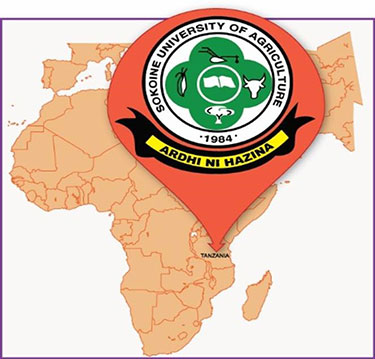
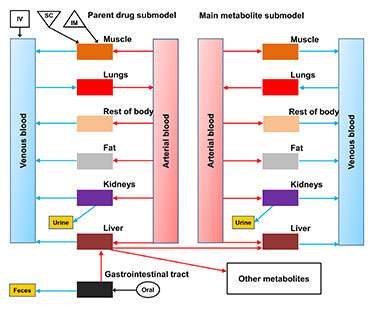

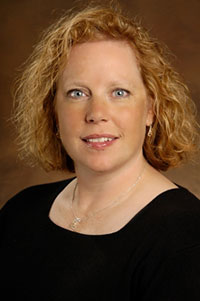 Dean Tammy Beckham said, “Dr. Schmidt brings an outstanding skill set and a great deal of passion for promoting excellence in veterinary education. Through this position, the College of Veterinary Medicine at K-State will have the opportunity to grow and enhance our nationally recognized professional program. Dr. Ronnie Elmore, associate dean for admissions and diversity programs, will continue to lead admissions and diversity for our DVM program.”
Dean Tammy Beckham said, “Dr. Schmidt brings an outstanding skill set and a great deal of passion for promoting excellence in veterinary education. Through this position, the College of Veterinary Medicine at K-State will have the opportunity to grow and enhance our nationally recognized professional program. Dr. Ronnie Elmore, associate dean for admissions and diversity programs, will continue to lead admissions and diversity for our DVM program.”